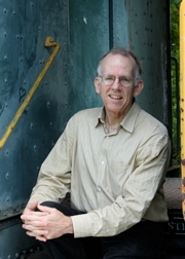
Paul Cawood Hellmund of the Conway School, a graduate program in sustainable planning and design in Massachusetts, visited Hamilton on Oct. 17 to lecture on his experience creating and sustaining greenways for the Levitt Center’s Sustainability series. He co-edited the widely acclaimed Ecology of Greenways, which received a national award from the American Society of Landscape Architects.
Hellmund presented the lecture as a narrative of his personal interaction with green, open spaces. The greenway, he explained, is an ecological highway—a strip of land to serve both people and wildlife. These could be parks, bike path, or walk ways that reunite the often divided urban and wild landscapes. As Hellmund explains, “As humans we live amidst fragmentation. We live by fragmentation…. We cut up the wild into smaller and smaller pieces.” Greenways are designed to reconnect these divisions.
But the impact of greenways is far greater than just environmental preservation; Hellmund stresses their aesthetic and practical value. They preserve biodiversity, help control water resources, protect cultural and historical resources and offer recreation. They can also be used for environmentally friendly transportation.
Hellmund described one such greenway near his former home in Fort Collins, Colo. This bike path followed a small stream running through the city. “I didn’t drive to work for years,” he explained, “kids could go to school without crossing the street.” The city was developed for cars, with wide streets and small sidewalks; the bike path offered a safer, calmer commute.
However, this greenway was not entirely tame; in fact it was quite wild. Foxes and birds abounded in the pastures and forests along this stream. Sometimes, “mountain lions and bears came out of the foot hills and used the greenways to get into the city,” Hellmund explained. Wildlife use these paths to commute just as humans do.
“When you go along a bike path like this, you experience all an area has to offer,” said Hellmund, who believes urban landscapes should cohabit with the wild. These greenways are becoming more popular across the United States; as populations expand and cities develop, they must address the local environment. It is Hellmund’s job to ensure wildlife is integrated into city planning and development.
However, this task is not as simple as erecting a preservation area. Greenways must accommodate animals that need protection from light, wind, loud noises and, above all, predators. “If we want to fit into the environment,” Hellmund explained, “we have to consider all the players out there.”
Hellmund went on to describe one of the largest and most ambitious plans to date for a system of greenways in Chatfield Basin, Colo. The city already had a series of small preservation areas, each of which was individually too small to support much ecological diversity. The idea behind the project was to connect each preserve with a greenway, creating a network of wild habitat within Chatfield Basin.
The project worked off the idea of “creative fragmentation,” a model Hellmund still uses in planning greenways today. As Hellmund explained, “If fragmentation is inevitable, it can be guided.” A whole new landscape was developed from these paths—animals could pass from habitat to habitat, and the residents of Chatfield Basin benefited from nearby trails and paths. The plan generated millions of dollars in support, and required years of litigation and planning to accomplish.
Hellmund urges even more support for greenways across the United States. During his lecture, he asked the audience jokingly to consider creating a bike path from Hamilton College to New York City. He admitted the plan appeared incredibly ambitious at first. But he persisted, “why not?”
